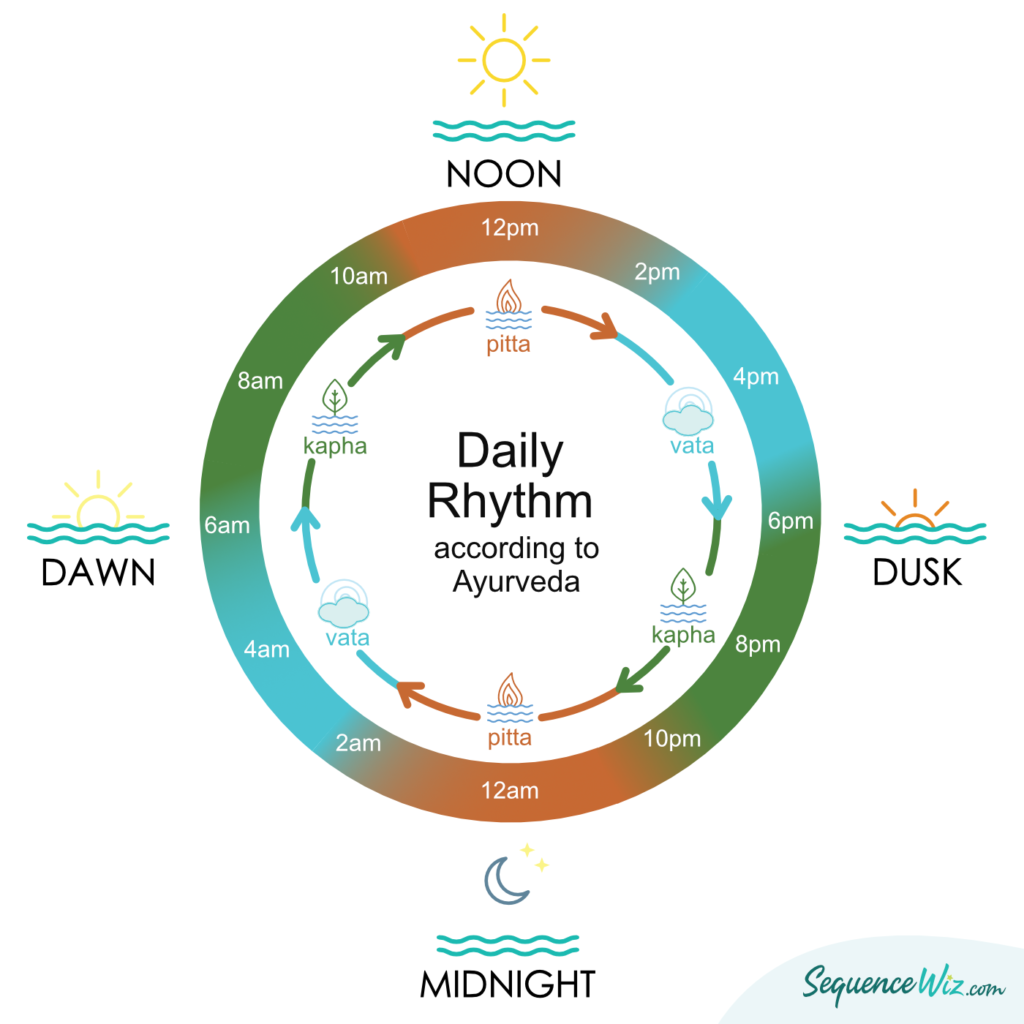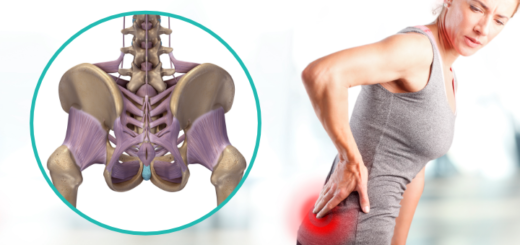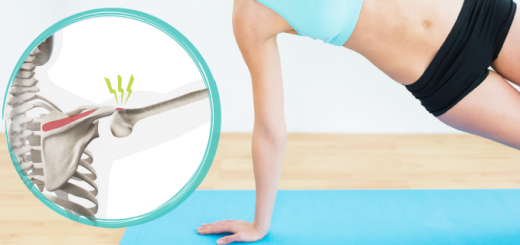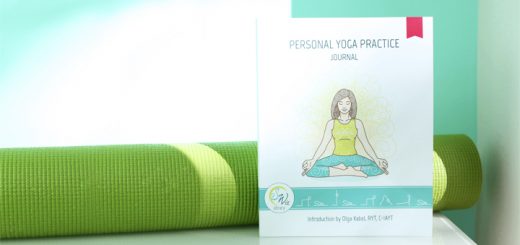How in tune are you with the daily dosha rhythms and why does it matter?
2A recently published study from the United Kingdom had identified the “sweet spot” for bedtime. The researchers concluded that going to bed between 10 pm and 11 pm lowered the risk of cardiovascular disease by as much as 25%, particularly for women. Dr. David Plans, the study’s author, attributes this to circadian rhythms. He explains: “The body has a 24-hour internal clock, called circadian rhythm, that helps regulate physical and mental functioning. While we cannot conclude causation from our study, the results suggest that early or late bedtimes may be more likely to disrupt the body clock with adverse consequences for cardiovascular health.” (1)
I cannot speak to the cardiovascular impact of bedtimes from personal experience, but I can unequivocally state that I get the best quality of sleep when I go to bed between 10 pm and 11 pm. If I miss this window and stay up later, it usually takes me an extra hour or longer to drift off. My mind becomes very active and starts replaying things from the past and planning for the future. I also get very hungry. Why does it happen every time? It is easy to explain this kind of response to a later bedtime from the Ayurvedic standpoint.
Ayurveda places great value on our internal rhythms and their alignment with the rhythms around us. Our environments are cyclical in nature in many ways, including the cycle of day and night, seasons of the year, and our lifespan in general. Women have an additional “season,” the menstrual cycle. Robert Svoboda, in his book Ayurveda for Women: A Guide to Vitality and Health, writes: “The rhythm of waxing and waning, of dilation and constriction, is central to embodied life. Our internal peristaltic waves, brain waves, and thought waves are all intricately interrelated with one another and with our external environments.”(2) All of nature is dependent on these cycles, but we, the humans, often lose touch with our internal rhythms and establish routines that override them, which can create ripples and dissonance in our physiology.
In Ayurveda, each one of those natural cycles is defined by increased dominance of a particular dosha. When a specific dosha becomes more dominant in our environment, its main qualities are heightened, impacting our constitution. For example, let’s look at the daily rhythm from the Ayurvedic perspective and how it can affect our functioning.
Each dosha becomes dominant for about eight hours in total at predictable times throughout the day. The transitions between dominant doshas do not happen abruptly; the potency of the dosha increases gradually until it reaches its peak and then slowly wanes, giving rise to the dosha that follows.

- Kapha dominates from dawn to mid-morning. It comes with gradual awakening from slumber, preparing for the day, and completing the elimination process.
- Pitta dominates from mid-morning to mid-afternoon. It comes with increased heat and mental and physical activity, focus on organization and planning.
- Vata dominates from mid-afternoon to dusk. It can manifest as a need to move, communicate and socialize, but can also show up as disorganized and unfocused mental activity.
- Kapha dominates from dusk to late evening. It invites us to slow down, assimilate the experiences of the day, turn inward, and prepare for sleep.
- Pitta dominates from late evening to the middle of the night. It comes with an increase in hunger and mental activity, a need for internal processing (while awake or asleep), and dreaming.
- Vata dominates from the middle of the night to dawn. It is characterized by lighter, more easily disrupted sleep, mental spinning during sleep interruption, as well as an opportunity for early morning spiritual practices.
You can analyze your daily routine from the perspective of dosha dominance to see how tuned in you are to those dosha rhythms. For example, earlier in the post, we have discussed “the sweet spot” of bedtime between 10 pm and 11 pm. 10 pm is the cusp at which kapha dosha, which is very conducive to sleep, begins to transition into pitta dosha, characterized by increased mental activity. If you fall asleep during kapha time, the mental activity will take place during your sleep, which is excellent for processing the impressions of your day (this is what dreaming does). If you are still awake as pitta dosha gathers strength, your mind will become more and more active, and processing will happen in an awake state, which will make you alert and hungry. After 2 am vata begins to kick in, so your sleep will be generally lighter and more easily disturbed. That is why it’s essential not to miss out on deep transformational pitta sleep between 10 pm and 2 am.
In the morning, kapha begins to build strength at about 6 am and reaches its peak around 8 am. This means that you are more likely to feel sluggish and have a harder time getting out of bed at 8 am or later. From the Ayurvedic standpoint, the most productive and active time is between 10 am and 2 pm, when pitta is dominant. Lunch is the most important meal of the day and can be larger because it feeds your pitta hunger, supports your digestive fire, and aids in the process of transformation (both physical and mental). Between 2 pm and 6 pm is vata time, which can be used well for creative pursuits and social interactions. However, vata can also become agitated, most often from sensory overstimulation, so it can be helpful to make your environment more peaceful and calming. Movement can also be very beneficial during this time, but only if it’s consistent, rhythmic, and not overly challenging. Kapha begins to gain strength around 6 pm and peaks at 8 pm. This is a great time to slow down, become more focused on family and other connections, turn inward, and begin the process of unwinding for the night.
Of course, these are just some general ideas, and a lot will depend on your Ayurvedic constitution and your personal daily rhythms. A lot will also depend on other cycles that your body simultaneously exists within—the cycles of seasons and your lifespan. We will talk about those cycles next time—tune in!
[jetpack_subscription_form]
References
-
The ‘Sweet Spot’ for Bedtime: Between 10 p.m. and 11 p.m. Is Best for Heart Health
- Ayurveda for Women: A Guide to Vitality and Health by Dr. Robert E. Svoboda (affiliate link)




















Interesting article. Especially the ‘Pitta’ from 10 pm (22:00) until 2 a.m. intrigues me…..
I’ve heard 3 interesting findings from from research
1) appr 50% of humans have a rhythm of going to bed at 2 a.m. and 50% prefers going to bed earlier.
2) Some research also pointed out that the health of those preferring to go to bed at 2 a.m. is less good. Alas.. this research didn’t distinguish between people actually sticking to this preferred rhythm and people who prefer 2 a.m. as bedtime but go to bed earlier because of school and office hours the next day. It might be possible that it is the latter group that has the health problems because they adapt to a rhythm that is not theirs
3) Chronic stress causes high levels of cortisol, which has been linked to disturbed night/day cycles. One effect is that around 10 p.m. (22:00) you become wide awake. This may keep a person up until the ‘small’ hours. 22:00… that is with the onset of the ‘Pitta’ during the night in your illustration.
So ..is going to bed at 2 a.m. a natural variety or stress induced?
I can imagine that at least 50% of humans has chronic stress in this world, so maybe that’s it?
I’m going to let your article sink in and see what insights it gives me in relation to those research outcomes I mentioned
Thank you for posting ,
And for your great yoga videos of course :),
Jo
PS:
Personally… my rhythm is sleeping from 2 am until 9 a.m. THe Pitta during the day, as you describe it, is what I experience between 22:00 en 2:00 at night : increased heat and mental and physical activity, focus on organization and planning.
A lifelong VP here: I can still hear Chase saying “last sleep train leaves at 10 pm”!
Fortunately my system has always felt in sync with this rhythm, though I work with many people who are not.
I do believe much of the dissonance is due to lifestyle–it’s easy to say “I’m a night owl” to escape making important changes– although of course there are some true night owls. I’m hoping to investigate this more in the new year with a new mini course. 🙂